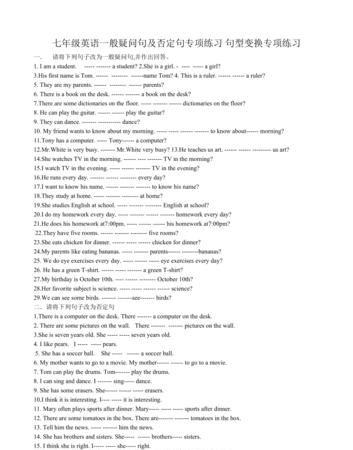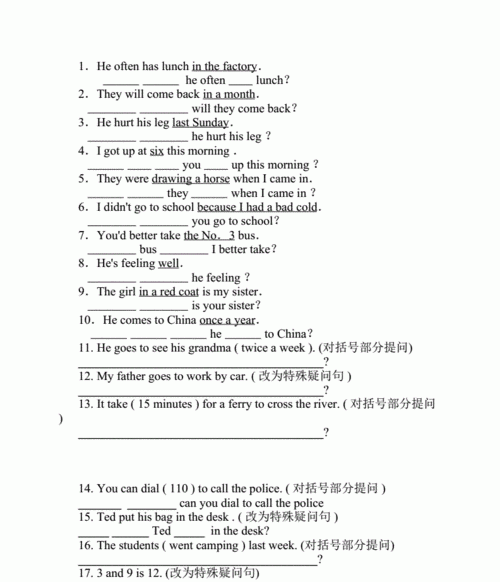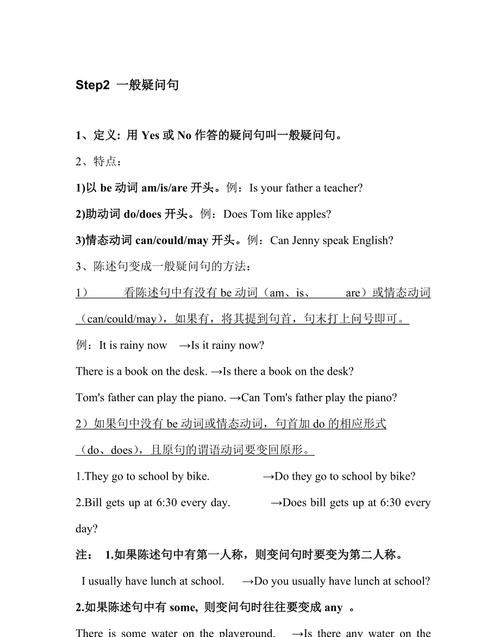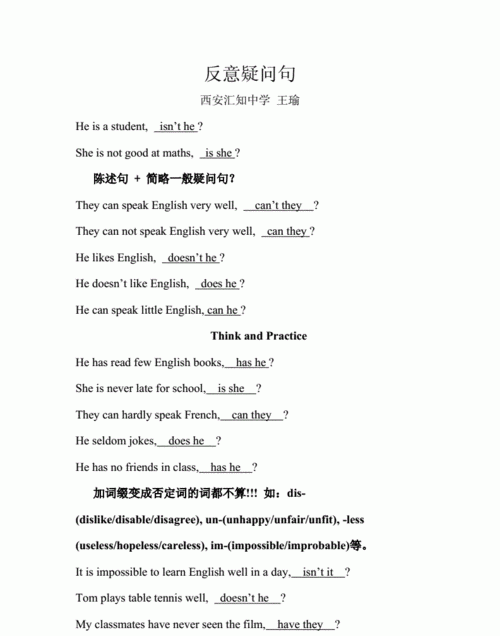本文目录
初一下册的英语语法知识点总结手抄报
语法是英语考试中的重中之重,所占分值也多。提高英语能力的方法是多读多练多积累。我在这里整理了初一下册的英语语法供大家阅读,希望能帮助到您。
初一下册英语语法
一. 情态动词can的用法
can+动词原形,它不随主语的人称和数而变化。
1. 含有can的肯定句:主语+can+谓语动词的原形+其他。
2. 含有can的否定句:主语+can't+动词的原形+其他。
3. 变一般疑问句时,把can提前:Can+主语+动词原形+其他? 肯定回答:Yes,主语+can。否定回答:No,主语+can't.
4. 含有can的特殊疑问句:特殊疑问词+can+主语+动词原形+其他?
I can speak English.→I can't speak English.→Can you speak English? →What can you speak?
二.、what time和when引导的特殊疑问句
1. 询问钟点时用what time,询问日期、月份、年份时用when。
2. What's the time?=What time is it?现在几点了?
3. 时刻表达法:顺读法和逆读法。
顺读法:“钟点+分钟”直接读数字。
如:7: 05 seven five;8:16 eight sixteen
逆读法:借助介词past或to表示,要先说分再说钟点。
a. 当分钟不超过30分钟时(包括30分钟),即<或=30,用past表示。其结构为:“分钟+past+整点” 意为“几点过几分”。
如:1:25 twenty-five past one
b. 当超过30分钟时,即>30,用to表示。其结构为:“所差分钟(即60—所 过分钟数)+to+下一个整点”,to译成“差”,差几分钟到几点。
如:4:38 twenty-two to five
c. 当分钟为30分钟用half表示,当分钟为15分钟用a quarter。
三、 how引导的特殊疑问句
1. how 引导的特殊疑问句提问交通方式,其答语分三种情况:
a. take a/an/the+交通工具(单数)
b. by+交通工具(单数)
c. on/in+限定词+交通工具
---How do you go to school every day?
---I take a bus to go to school every day./I go to school by bus every day./I go to school on the bus every day.
2. how far 用来提问距离,多远,其答语分为两种:
(1)用长度单位表示:It is five kilometers.
(2)用时间表示:It’s twenty minutes’walk.
3. how long 用来提问时间,意为多久回答常用“for+段时”。
----How long have you learnt English?
----For 3 years.
4. how soon 用来提问做完某事还需要多长时间, 用于将来时态, 常用“in+时间段”来回答。
----How soon will you arrive in Beijing? ----In 3 hours.
四. 祈使句
祈使句一般表示请求、命令、劝说、号召、警告等。一般以动词原形开头,句末可以用感叹号或句号。
1. 肯定的祈使句:
(1) 实义动词原形+其他 :Please look at that boy.
(2) be动词原形+形容词+其他:Be quiet, please.
2. 否定的祈使句:
(1) Don’t+实义动词+原形 Don't stand there.
(2) Don’t be+形容词+其他 Don't be so noisy.
(4) No+n./V-ing
No photos. 不许照相。
No talking. 不许谈话。
五. 现在进行时
现在进行时指当前时间正在发生的动作。常与now,at this moment,listen,look等词连用。
1. 现在进行时的基本结构
肯定式:am/is/are+doing(现在分词),否定式:am/is/are not +doing(现在分词),一般疑问式:Am/Is/Are + 主语 +doing(现在分词)+ 其他,特殊疑问式:特殊疑问词+一般疑问式
They’re having a meeting now. 他们现在正在开会。
They aren't having a meeting now. 他们现在没有在开会。
Are they having a meeting now? 他们现在正在开会吗?
What are they doing now? 他们现在正在做什么?
2. 现在进行时的基本用法
(1)表示此时此刻正在发生的事情。常与now,at the moment,look,listen等词连用。
The little boy is watching TV now. 这个小男孩现在正在看电视。
Listen!She is playing the guitar in the next room. 听!她正在隔壁房间弹吉他。
(2)表示现阶段一直在进行着或是重复发生着的动作,不强调此时此刻正在做。常与表示时间段的时间状语连用。
I am studying computer this term. 这个学期我一直在学习计算机。
(3)表示说话人褒义或贬义的情感色彩,如赞许、批评、喜欢、厌恶等。此时常与alway、often等频度副词连用。
He is always thinking of others , not of himself. 他总是为他人着想,而不为自己。(表示赞许)
One of my roommates is often leaving things about. 我的一个室友经常乱扔东西。(表示不满)
(4)表示在近期按计划或安排要发生的动作。(现在进行时表示一般将来的含义。)
① 瞬时动词的进行时在任何情况下都表示将来含义。这些动词包括go , come , leave,arrive , return等。
I am leaving. 我将要离开了。
I am leaving tomorrow. 我将会明天离开。
② 持续动词的进行时,只有在有将来时间状语或将来语境的情况下才可以表示将来含义。An American professor is giving a lecture this afternoon. 今天下午一位美国教授将要作报告。(将来含义)
An American professor is giving a lecture. 一个美国教授正在作报告。(进行含义)
3. 现在分词(doing)的变化规则
(1)一般在情况下,在动词词尾加-ing。
go——going
play——playing
know——knowing
(2)以不发音的字母e结尾动词,先去e再加-ing。
make——making
arrive——arriving
come——coming
(3)以重读闭音节结尾,且动词词尾只有一个辅音字母时,先双写这个辅音字母,再加-ing。
run——running
stop——stopping
swim——swimming
run——running
put——putting
sit——sitting
begin——beginning
plan——planning
cut——cutting
get——getting
shop——shopping
chat——chatting
regret——regretting
dig——digging
(4)以-ie结尾,先将-ie改成y,再加-ing。
tie——tying
die——dying
lie——lying
六. There be结构
1. There be句型主要用以表达“某处有某人(某物),强调存在”其基本结构为“There be+某物(某人)+某地”,有时为了强调地点,也可把地点状语放在句首。
There is a book on the desk.
On the desk there is a book.
(1)肯定句:“There be+主语(某人/某物)+介词短语”
There are three people in my family. 我家有三口人。
There is a pen and two books on the desk. 书桌上有一支钢笔和两本书。
(2)否定式:“There be +not+主语+介词短语”
There isn’t a boy in the room.房间里没有一个男孩。
There aren’t any books on the desk.书桌上没有书。
注意:“There be句型”的否定式的构成和含有be动词的其他句型一样,在be后加not或no即可。
注意not和no的不同:not是副词,no为形容词,所以not a/an/any+n,相当于no+n。
There aren’t any pictures on the wall.=There are no pictures on the wall.
There isn’t a bike behind the tree.=There is no bike behind the tree.
(3)疑问式:Be there+主语+介词短语?”
肯定回答是:“Yes, there be.”否定回答是:“No, there+be与not的缩写形式”。
—Is there a lamp in your bedroom?在你的卧室里有台灯吗?
—Yes, there is.是的,有。
—Are there any clock in the living room?客厅里有钟吗?
—No, there aren’t.不,没有。
(4)特殊疑问句:一般有两种句型结构
How many+复数名词+are/were there+介词短语?
There’re many children in the park.
How many children are there in the park?
How much+不可数名词+is/was there+介词短语?
There was little rain around the year.
How much rain was there around the year?
2. have表示“某人拥有某人或某物,强调拥有和所属关系”。
The man has two cars.
3. There be句型中的就近原则,即be和距其最近的主语保持一致。
There are some pens and a book on the floor. =There is a book and some pears on the floor.
七. 选择疑问句
选择疑问句是指说话人提出两种或以上的情况,让对方选择是哪一种,两个选择部分用or连接。选择疑问句不用yes或no来回答,直接在两个选择里选一个回答。
---Is she tall or short? ---She is tall.
---Can you play the piano or play the guitar? ---I can play the piano
八. 既是可数名词又是不可数名词的单词
chicken当“鸡肉”讲时是不可数,当“小鸡”讲时可数;
room当“空间”讲时不可数,当“房间”讲时可数;
fish当食物用“鱼、鱼肉”讲时不可数,当“鱼的种类”讲时可数;
hair泛指“毛发”时不可数,当“一根或几根毛发”讲时可数;
sound意思是“一般性的声音”时,不可数,指“一次发出的声音”时可数;
paper当“纸”讲时不可数,当“试卷”、“论文”、“证件”讲时可数;
time当“时间”讲时不可数,当“时代、倍数、次数”讲时可数;
exercise泛指“锻炼”时不可数,当“练习、做操”讲时可数
九. 一般过去时
一般过去时表示在过去某个时间所发生的动作或所处的状态(与现在无关) 。常与yesterday, last week, in 1989, just now, a moment ago, the other day等过去具体时间状语连用。
He was here just now.
他刚才还在这里。
What did you do yesterday?
你昨天做了什么事?
一般过去时基本结构
1. 肯定句形式:主语+动词过去式+其他
I was an English teacher one year ago.
一年前我是一名英语老师。
I bought a yellow dress yesterday afternoon.
昨天下午我买了一条黄裙子。
2. 否定句形式:①was/were+not; ②在行为动词前加didn't,同时还原行为动词
I wasn't an English teacher one year ago. 一年前我不是一名英语老师。
I didn't buy a yellow dress yesterday afternoon. 昨天下午我没买一条黄裙子。
3. 一般疑问句:①was/were提到句首; ②Did+主语+动词原形+其他?
Were you an English teacher one year ago? 一年前你是一名英语老师吗?
Did you buy a yellow dress yesterday afternoon? 昨天下午你买了一条黄裙子吗?
4. 特殊疑问句:特殊疑问词+一般疑问句
What were you one year ago? 一年前你是做什么的?
学好初中英语的建议
一、明确学习动机
同学们要知道,我们学习英语最直接的目的是什么?就是为了能考上好大学。学习成绩好的同学,大部分都是有意无意的遵循了学习规律,有了自己的一套学习方法,养成了良好的学习习惯。
然而成绩不是很好的同学则看不到上大学的希望,因而失去了学习的原动力,也就是学习动机,怎么办呢?
这个时候就我们需要告诉自己,凡事积极乐观,有自信,有恒心,有坚韧不拔的毅力,成功是早晚的事,成绩不好只是暂时。
就拿学习英语来说,要看到学好英语,说好英语的作用,我们都知道,成功从来都是偏向有准备的人,多一项本领,将来就会多一项选择。
二、爱上英语
想学好哪一学科,首先要爱上这一学科,这也就是我们所说的学习兴趣。兴趣不是与生俱来的,可以是老师的培养,可以是家庭环境影响。
如果这两个条件你都没有,那么我们就自己来想办法吧。有两个好办法:
一个是从我们感兴趣的英文电影开始吧。具体看什么电影,现在网络方便,同学们都能查找到的。电影的选择一定是原声的,最好是中英文双字幕,反复多次看几遍。
另一种方法就是朗读背诵课文,在教学中我一直强调阅读,因为我认为阅读是其他项目的基础,它是输入,是吸收,而各方面的运用则属于输出。
没有输入哪来输出?不读文章怎么会写文章呢?这个方法在百家号人生底色看语文的上一篇文章中有详细介绍,同学们可以搜索查看。
坚持这两种方法,你会慢慢爱上英语的,你会发现越看越喜欢,越读越有自信,这么做还有一个最大的好处是可以培养英语语感。
三、坚强意志
坚强的意志能使人在各种环境中奋发向上,自强不息。
同学们的思维活跃,兴趣广泛,求知欲强,但缺乏持久的恒心和毅力,所以我们要做的是善于发现自己的进步与不足。
树立信心、决心和恒心,战胜学习上的困难,走向成功
本次整理就到这里啦,祝大家在考试中能金榜题名!

七年级英语改一般疑问句专项训练题
Is this your English book?
Are these your English books?
Can you speak English?
Do your parents like English?
Can you speak English?
Are you an English teacher?
Can you speak English fluently?
Do you read English every morning?
Does Tom’s father listen to English on the radio every evening?
Is there any tea in the cup?
Do you have any children?
May I have some fish?
Would you like some tea?
. Shall we buy some vegetables?
Can I borrow some money from you?
Why not have some bread?
How about some orange juice?
Are you not a football fan?
Aren’t you a football fan?
Will she not like it?
Won’t she like it?
Is he a manager?
Does she usually go to work by bus?
Are there fifty students in the class?
Do they have a large house?
Is he currently working on TV advertisements?
Was it rainy yesterday?
Can Tom's father play the piano?
Have you finished your homework?
先来几个

人教版英语七年级下册语法知识点汇总
因为有知识,我们在近一百年的时间内所创造出来的财富超过了以往历史的总和。下面我给大家分享一些英语七年级下册语法知识,希望能够帮助大家,欢迎阅读!
英语七年级下册语法知识1
1. 情态动词+V原 can do= be able to do
2. Play+ the+ 乐器
+球类,棋类
3. join 参加社团、组织、团体
4. 4个说的区别:
say+内容
Speak+语言
Talk 谈论 talk about sth talk with sb talk to sb
Tell 告诉,讲述 tell sb (not)to do sth
Tell stories/ jokes
5. want= would like +(sb)to do sth
6. 4个也的区别:too 肯定句末 (前面加逗号)
Either否定句末(前面加逗号)
Also 行前be 后
As well 口语中(前面不加逗号)
7. be good at+ V-ing=do well in 擅长于
be good for 对…有益 (be bad for对…有害)
be good to 对…友好 (good 可用friendly,nice,kind替换)
be good with和…相处好=get>8. 特殊疑问句的构成:疑问词+一般疑问句
9. How/ what about+V-ing …怎么样?(表建议)
10. 感官动词(look, sound, taste, smell, feel)+adj/ like
11. 选择疑问句:回答不能直接用Yes或者No,要从中选择一个回答
12. students wanted for school show(wanted表示招募,含有被动意义)
13. show sth to sb=show sb sth
give sth to sb=give sb sth
14. help sb (to)do sth
Help sb with sth
With sb’s help= with the help of sb
Help>15. be busy doing sth/ be busy with sth
16. need to do sth
17. be free= have time
18. have friends= make friends
19. call sb at +电话号码
20.on the weekend= on weekends
21. English-speaking students 说英语的学生(带有连词符,有形容词性质)
22. do kung fu表演功夫
英语七年级下册语法知识2
1. 问时间用what time或者when
At+钟点 at 7 o’clock
at noon/ at night(during/ in the day)
On+ 具体某天、星期、特指的一天
on April 1st on Sunday on a cold winter morning
In +年、月、上午、下午、晚上
2. 时间读法:顺读法
逆读法:分钟≤30用past
five past eight(8:05) half past eight(8:30)
分钟>30用to a quarter to ten(9:45)
整点用 …o’clock 7 o’clock(7:00)
3. 3个穿的区别:
wear 表状态,接服装、手套、眼镜、香水等
Put>Dress 表动作,接sb/>
4. from…to…
5. be/ arrive late for
6. 频度副词(行前be后)
Always usually often sometimes
seldom hardly never
7. 一段时间前面要用介词for
for half an hour for five minutes
8. eat/ have… for breakfast/ lunch/ dinner/ supper
9. either…or
10. a lot of=lots of
11. it is +adj+for sb +to do sth (adj修饰to do sth)
It is important for me to learn English.
it is +adj+of sb +to do sth (adj修饰sb)
It is kind/ friendly/ nice of you to help me.
12. 感叹句:How+adj+主谓!
How+adj+a/an +n单+主谓!
What+ a/an +adj+ n单+主谓!
What+ adj+ n复/ 不可数+主谓!
英语七年级下册语法知识3
1. 疑问词
How 如何(方式)
how long 多长(时间)答语常用“(For/ about +)时间段”
how far多远(距离)答语常用“(It’s +)数词 +miles/ meters/ kilometers”
how often多久一次(频率)答语常用“Always/ often/ every day/…”或 “次数+时间”等表频率的状语
How soon多快,多久以后,常用在将来时中。答语常用“in +时间段”
how many多少(接可数名词) how much(接不可数名词)
why为什么(原因) what什么 when何时
who谁 whom谁(宾格)(针对宾语提问也可用who) whose谁的
2. 宾语从句要用陈述句语序
3. Stop sb from doing sth
Stop to do 停下来去做其他事
Stop doing 停止正在做的事
4. what do you think of/ about…?= how do you like…?
你认为…怎么样?
5. He is 11 years old.
He is an 11-year-old boy.
6. many students= many of the students
7. be afraid of sth be afraid to do sth
worry about be worried about 担心
8. play with sb
9. come true
10. have to do sth
11. he is like a father to me (like像)
12. leave离开 leave for 出发前往某地
13. cross 是动词 across是介词
14. thanks for +n/ V-ing
Thanks for your help/ thanks for helping me.
Thanks for your invitation/ thanks for inviting/ asking me.
Thanks to幸亏,由于,因为
15. 4个花费:
人+spend/ spends/ spent+时间/钱+(in)doing sth/>人+pay/ pays/ paid +钱+for sth
It takes/ took sb +时间+to do sth
物+cost/ costs/ cost +sb +钱
16. 交通方式
●用介词。在 句子 中做方式状语。
①by +交通工具名词(中间无需任何修饰)
By bus/ bike/ car/ taxi/ ship/ boat/ plane/ subway/ train……
②by +交通路线的位置
By land/ water/ sea/ air
③in/>In a/ his/ the car
On a/ his/ the bus/ bike/ship/ train/ horse/ motorbike
④on foot 步行
●用动词。在句子中做谓语。
①take + a/ the +交通工具名词
take a bus/ plane/ ship/ train
ride a bike
②walk/ drive/ ride/ fly to……(后面接here,there,home等地点副词时,省略介词to。)如步行回家:walk home
17. 名词所有格
(1)一般情况加’s Tom’s pen
(2)以s结尾加’ the teachers’ office ten days’ holiday
(3)表示几个人共同拥有,在最后一个名词后加’s
Mike and John’s desk
(4)表示每个人各自拥有,在每个名词后加’s
Mike’s and John’s desks
英语七年级下册语法知识4
1. 祈使句(变否定在句首+don’t)
Be型(be +表语),否定形式:don’t + be +表语
Be quiet,please. Don’t be late!
Do型(实义动词+其他),
否定形式:don’t +实义动词+其他
Come here,please. Don’t play football here.
Let型(let sb do sth),
否定形式:don’t + let sb do sth或者let sb not do sth
No+n/ V-ing No photos /mobile;
No parking/ smoking/ spitting/ talking/ picking of flowers
2. in class在课堂上 in the classroom 在教室
3. be on time准时
4. listen to music
5. (have a)fight with sb
7. eat outside
8. Must 与have to
(1)must 表示说话人主观上的看法,意为“必须”。have to 表示客观的需要或责任,意为“不得不,必须”,后接动词原词。
(2)must没有人称,时态和数的变化Have to 有人称,数,时态的变化,其第三人称单数形式为 has to ,过去式为had to. 构成否定句或疑问句时借助动词do/ does。
(3)have to的否定式是needn’t=don’t / doesn’t have to (不必要);must的否定式是must not/ mustn’t(一定不能,不允许)。
9. Some of…
10. bring…to…
11. practice (doing)sth
12. wash/ do the dishes
13.on school days/ nights
14. break/ follow(obey)the rules
15. Be strict with sb/>be strict in sth对……严格。
16. too many“太多”修饰可数名词复数
too much“太多”修饰不可数名词
much too“实在太”修饰形容词或副词
17. make one’s/ the bed
18. get to, arrive in/at, reach,到达(如果后面接地点的副词home,here或there ,就不用介词in ,at, to)
19. remember/ forget+to do要做
+doing做过
20. have fun enjoy>have a good/ great/ wonderful time+V-ing
英语七年级下册语法知识5
1. 回答why的提问要用because
2. Kind of 相当于副词,修饰形容词或副词,意为“稍微,有点”,与a little/ bit 相近
A kind of 意为“一种”,some kinds of 意为“几种”,all kinds of 意为“各种各样的”。这里的kind 是“种,类,属”的意思。
3. Why not =Why don’t you+V原 你为什么不…?
4. walk on one’s legs/ hands on 意为“用…方式行走”
5. all day =the whole day整天
6. 来自be/ come from
where do they come from?=where are they from?
7. more than=over超过 less than 少于
8.once twice three times
9. be in great danger
10.one of… …之一 +名词复数
11. get lost
12. with/ without 有/ 没有 介词
13. a symbol of
14. 由…制造 be made of能看出原材料
be made from 看不出原材料
be made in+地点 表产地
15. cut down 砍到
动副结构(代词必须放中间,名词可放中间或者后面)
人教版英语七年级下册语法知识点相关 文章 :
★ 七年级英语下册语法重点知识点总结
★ 七年级英语语法知识点整理
★ 初一英语全册语法知识点汇总
★ 人教版英语七年级下册知识点
★ 七年级英语语法知识点归纳整理
★ 最全七年级英语语法知识点汇总
★ 七年级英语下册语法总结
★ 初一英语语法知识点总结归纳
★ 初一英语语法及知识点归纳
★ 初一英语必备语法知识点归纳

七年级英语上册语法总结
英语语法是一个非常重要的知识点,如何学习好语法却是需要好的 学习 方法 的,下面是我给大家带来的 七年级英语 下册语法 总结 ,希望能够帮助到大家!
七年级英语下册语法总结
一、七年级下英语语法——词法
1、名词A)、名词的数我们知道名词可以分为可数名词和不可数名词,而不可数名词它没有复数形式,但可数名词却有单数和复数之分,复数的构成如下:
一)在后面加s。如:fathers, books, Americans, Germans, apples, bananas
二)x, sh, ch, s, tch后加es。如:boxes, glasses, dresses, watches, wishes, faxes
三)1)以辅音字母加y结尾的变y为i再加es 如:baby-babies, family-families, duty-duties, comedy-comedies, documentary-documentaries, story-stories
2)以元音字母加y结尾的直接加s。如:day-days, boy-boys, toy-toys, key-keys, ways
四)以o结尾加s(外来词)。如:radios, photos, 但如是辅音加o的加es:如: tomatoes西红柿, potatoes马铃薯
五)以f或fe结尾的变f为v再加es(s)。如:knife-knives, wife-wives, half-halves, shelf-shelves, leaf-leaves, yourself-yourselves
六)单复数相同(不变的)有:fish, sheep, deer鹿子, Chinese, Japanese
七)一般只有复数,没有单数的有:people,pants, shorts, shoes, glasses, gloves, clothes, socks
八)单词形式不变,既可以是单数也可以是复数的有:police警察局,警察, class班,同学, family家,家庭成员
九)合成的复数一般只加主要名词,多数为后一个单词。如:action movie-action movies, pen pal-pen pals; 但如果是由man或woman所组成的合成词的复数则同时为复数。如:man doctor-men doctors, woman teacher-women teachers
十)有的单复数意思不同。如:fish鱼 fishes鱼的种类, paper纸 papers报纸,卷子,论文, work工作 works作品,工厂, glass玻璃 glasses玻璃杯,眼镜, orange桔子水 oranges橙子, light光线 lights灯, people人 peoples民族, time时间 times时代, 次数, chicken 鸡肉 chickens 小鸡
十一) 单个字母的复数可以有两种形式直接加s或’s。如:Is (I’s), Ks (K’s)。但如是缩略词则只加s。如:IDs, VCDs, SARs
十二) 特殊形式的有:child-children, man-men, woman-women, foot-feet, mouse-mice, policeman-policemen, Englishman-EnglishmenB)名词的格当我们要表示某人的什么东西或人时,我们就要使用所有格形式。构成如下:
一)单数在后面加’s。如:brother’s, Mike’s, teacher’s
二)复数以s结尾的直接在s后加’,如果不是以s结尾的与单数一样处理。如:Teachers’ Day 教师节 , classmates’; Children’s Day六一节, Women’s Day三八节
三)由and并列的名词所有时,如果是共同所有同一人或物时,只加最后一个’s,但分别拥有时却分别按单数形式处理。如:Mike and Ben’s room迈克和本的房间(共住一间),Mike’s and Ben’s rooms迈克和本的房间(各自的房间)
2、代词项目 人称代词物主代词指示代词反身代词人称 主格宾格形容词 名词性第一人称 单数 I me my mine myself复数 we us our ours ourselves第二人称单数 you you your yours yourself复数 you you your yours yourselves第三人称 单数 she her her hers herselfhe him his his himselfit it its its this that itself复数 they them their theirs these those themselves3、动词A) 第三人称单数当动词是第三人称单数时,动词应该像名词的单数变动词那样加s,如下:
一)一般在词后加s。如:comes, spells, waits, talks, sees, dances, trains
二)在x, sh, ch, s, tch后加es。如:watches, washes, wishes, finishes
三)1)以辅音字母加y结尾的变y为i再加es。如:study-studies, hurry-hurries, try-tries2)以元音字母加y结尾的直接加s。如:plays, says, stays, enjoys, buys
四)以o结尾加es。如:does, goes五)特殊的有:are-is, have-hasB) 现在分词当我们说某人正在做什么事时,动词要使用分词形式,不能用原形,构成如下:
一)一般在后加ing。如:spell-spelling, sing-singing, see-seeing, train-training, play-playing, hurry-hurrying, watch-watching, go-going, do-doing
二)以不发音e的结尾的去掉e再加ing。如:dance-dancing, wake-waking, take-taking, practice-practicing, write-writing, have-having
三)以重读闭音节结尾且一个元音字母+一个辅音字母(注意除开字母组合如show –showing, draw-drawing)要双写最后的辅音字母再加ing。如:put-putting, run-running, get-getting, let-letting, begin-beginning
四)以ie结尾的变ie为y再加ing。如:tie-tying系 die-dying死 lie-lying 位于
4、形容词的级我们在对两个或以上的人或物进行对比时,则要使用比较或最高级形式。构成如下:
一) 一般在词后加er或est(如果是以e结尾则直接加r或st)。如:greater-greatest, shorter –shortest, taller –tallest, longer –longest, nicer- nicest, larger –largest
二)以重读闭音节结尾且1个元音字母+1个辅音字母(字母组合除外,如few-fewer fewest)结尾的双写结尾的辅音再加er /est。如:big-bigger biggest, red-redder reddest, hot-hotter hottest
三) 以辅音字母+y结尾的变y为i加er/est。如:happy-happier happiest, sorry-sorrier sorriest, friendly-friendlier friendliest(more friendly most friendly), busy-busier busiest, easy-easier easiest
四)特殊情况:(两好多坏,一少老远)good/well - better best many/much - more most bad/ill – worse worstlittle- less least old- older/elder oldest/eldest far- farther/further farthest/furthest
5、数词 (基变序,有规则;一、二、三,自己背;五、八、九、十二; 其它 后接th;y结尾,变为i, eth跟上去。) first, second, third; fifth, eighth, ninth, twelfth; seventh, tenth, thirteenth, hundredth; twenty-twentieth, forty-fortieth, ninety-ninetieth二、七年级英语语法——句式1.陈述句肯定陈述句 a) This is a book. (be动词)b) He looks very young. (连系动词)c) I want a sweat like this. (实义动词)d) I can bring some things to school. (情态动词)e) There’s a computer on my desk. (There be结构)否定陈述句 a) These aren’t their books. b) They don’t look nice.c) Kate doesn’t go to No. 4 Middle School. d) Kate can’t find her doll.e) There isn’t a cat here. (=There’s no cat here.)2. 祈使句肯定祈使句 a) Please go and ask the man. b) Let’s learn English!c) Come in, please.否定祈使句a) Don’t be late. b) Don’t hurry.3. 疑问句1) 一般疑问句a) Is Jim a student? b) Can I help you? c) Does she like salad?d) Do they watch TV? e) Is she reading?肯定回答: a) Yes, he is. b) Yes, you can. c) Yes, she does. d) Yes, they do. e) Yes, she is.否定回答: a) No, he isn’t. b) No, you can’t. c) No, she doesn’t. d) No, they don’t. e) No, she isn’t.
2) 选择疑问句Is the table big or small? 回答 It’s big./ It’s small.3) 特殊疑问句
① 问年龄 How old is Lucy? She is twelve.
② 问种类 What kind of movies do you like? I like action movies and comedies.
③ 问身体状况 How is your uncle? He is well/fine.
④ 问方式 How do/can you spell it? L-double O-K.How do we contact you? My e-mail address is cindyjones@163.com.
⑤ 问原因 Why do you want to join the club?
⑥ 问时间 What’s the time? (=What time is it?) It’s a quarter to ten a.m..What time do you usually get up, Rick? At five o’clock.When do you want to go? Let’s go at 7:00.
⑦ 问地方 Where’s my backpack? It’s under the table.
⑧ 问颜色 What color are they? They are light blue.What’s your favourite color? It’s black.
⑨ 问人物 Who’s that? It’s my sister.Who is the boy in blue? My brother.Who isn’t at school? Peter and Emma.Who are Lisa and Tim talking to?
⑩ 问东西 What’s this/that (in English)? It’s a pencil case.What else can you see in the picture? I can see some broccoli, strawberries and hamburgers.
11问姓名 What’s your aunt’s name? Her name is Helen./She’s Helen.What’s your first name? My first name’s Ben.What’s your family name? My family name’s Smith.
12 问哪一个 Which do you like? I like one in the box.
13 问字母 What letter is it? It’s big D/small f.
14 问价格 How much are these pants? They’re 15 dollars.
15 问电话号码 What’s your phone number? It’s 576-8349.
16 问谓语(动作) What’s he doing? He’s watching TV.
17 问职业(身份) What do you do? I’m a teacher.What’s your father? He’s a doctor.
三、七年级英语语法——时态
1、一般现在时 表示普遍、经常性的或长期性的动作时使用一般现在时,它有:Be 动词:She’s a worker. Is she a worker? She isn’t a worker.情态动词:I can play the piano. Can you play the piano? I can’t play the piano.行为动词:They want to eat some tomatoes. Do they want to eat any tomatoes? They don’t want to eat any tomatoes.Gina has a nice watch. Does Gina have a nice watch? Gina doesn’t have a watch.
2、现在进行时 表示动词在此时正在发生或进行就使用进行时态,结构为sb be v-ing sth + 其它.I’m playing baseball. Are you playing baseball? I’m not playing baseball.Nancy is writing a letter. Is Nancy writing a letter? Nancy isn’t writing a letter.They’re listening to the pop music. Are they listening the pop music? They aren’t listening to the pop music.

以上就是关于初一下册英语一般疑问句 ,初一下册的英语语法知识点总结手抄报的全部内容,以及初一下册英语一般疑问句 的相关内容,希望能够帮到您。

